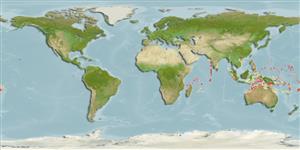>
Anguilliformes (Eels and morays) >
Muraenidae (Moray eels) > Uropterygiinae
Etymology: Anarchias: Greek, anarchia, -as = without a chief, lack of authority (Ref. 45335).
More on author: Schultz.
Environment: milieu / climate zone / depth range / distribution range
بوم شناسي
دريايي وابسته به آب سنگ. Tropical; 19°N - 21°S (Ref. 85321)
Indo-West Pacific: tropical, from central Indian Ocean in the west to the Phoenix and Line Islands in the east; southernmost records from about 21°S in Tonga, northernmost from about 19°N in the Philippines. Not recorded anywhere west of the Maldives, although it reaches as far as Palmyra I. in the east and does not occur in the Hawaiian Islands nor anywhere in French Polynesia.
Size / Weight / سن
Maturity: Lm ? range ? - ? cm
Max length : 21.9 cm TL جنس نر / بدون خواص جنسي; (Ref. 85321)
This species is distinguished from its congeners except A. exulatus and A. schultzi by the position of the fourth supraorbital pore, anteromedial to the posterior nostril and separated from it by an interval of normal, pigmented skin; fewer vertebrae 98-108 (vs. 110-117 in A. exulatus and 105-113 in A. schultzi); longer snout-anus distance 45.1-50.6% TL (vs. 40.3-45.1% in A. exulatus and 41.5-45.1% in A. schultzi); with discrete, sharply defined pale spots (vs. larger, more diffuse pale areas oriented vertically in A. exulatus and uniform brown of A. schultzi) (Ref. 85321).
Most specimens were collected in relatively shallow water on coral reefs and rocky areas along the shore and are not recorded deeper than 10 m. Cryptic and rarely, if ever seen except when collected with ichthyocides (Ref. 85321).
Life cycle and mating behavior
بلوغ | تولید مثل | تخم ریزی | تخم ها | Fecundity | توزاد ( لارو)
Reece, J.S., D.G. Smith and E. Holm, 2010. The moray eels of the Anarchias cantonensis group (Anguilliformes: Muraenidae), with description of two new species. Copeia 2010(3):421-430. (Ref. 85321)
وضعيت در فهرست قرمز IUCN (Ref. 130435: Version 2024-2)
خطر برای انسان ها
Harmless
استفاده انسانی
ماهي گيري – شيلات: از بی علاقه گی
ابزارها
گزارش های ويژه
بارگيری XML
منابع اينترنتي
Estimates based on models
Preferred temperature (Ref.
123201): 26.8 - 29.3, mean 28.5 °C (based on 1746 cells).
Phylogenetic diversity index (Ref.
82804): PD
50 = 0.5005 [Uniqueness, from 0.5 = low to 2.0 = high].
Bayesian length-weight: a=0.00069 (0.00033 - 0.00146), b=3.12 (2.93 - 3.31), in cm total length, based on LWR estimates for this (Sub)family-body shape (Ref.
93245).
Trophic level (Ref.
69278): 3.4 ±0.5 se; based on size and trophs of closest relatives
جهندگی (Ref.
120179): زياد, كمينه زمان لازم براي دو برابر شدن جمعيت ، كمتر از 15 ماه (Preliminary K or Fecundity.).
Fishing Vulnerability (Ref.
59153): Low vulnerability (12 of 100).
